When MGM refused to finance Savage Messiah (1972), filmmaker Ken Russell so completely believed in the project that he took out a second mortgage on his house in order to get the film made. What resulted can be described as “the Ken Russell movie for people who don’t like Ken Russell movies,” but the truth is that it’s also the film for those who not only like, but love Ken Russell movies. This biography of French sculptor Henri Gaudier (Scott Antony), whose life was changed when he met the lonely Polish writer Sophie Brzeska (Dorothy Tutin)—he was 18 and she was 38—is one of Russell’s warmest, richest, most emotional and, sadly, least known films. It’s also long been one of the hardest to see of the director’s theatrical films, a situation this screening goes a small way toward correcting.

When it was first released, MGM didn’t exactly pull out the stops to promote it. Its subject was obscure. Its stars were an unknown Scott Antony and the highly regarded stage star Dorothy Tutin. Neither name was marketable. The young Helen Mirren was not much better known—though in the UK her extended nude scene was a selling point—and the film was not exactly a commercial success. The pity of this is that nearly everyone who does see it falls completely in love with it at first sight. Here then is a chance to see why—and to see the notorious scene that “reveals Miss Helen Mirren full frontal in a scene longer than the normal glimpse.” (For those with an interest in this matter, there’s a glimpse shorter—and less revealing—than the actual scene to the right.)
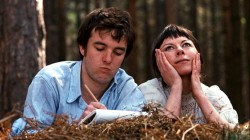
On its simplest level, Savage Messiah is a love story—a love story about a somewhat unusual couple, but a love story all the same. And that can be enough, but it’s so much more than that. I don’t think I realized how much more when I first saw it. It wasn’t until I started really digging into the film for the chapter in my old Ken Russell book that I understood the complexity of the movie. When I started the chapter, I’d assumed it would be one of the shorter sections of the book. Instead, it was one of the longest. It turns out that Savage Messiah is not a film that gives up secrets easily.
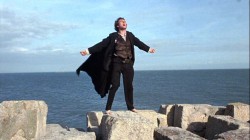
It’s worth noting that Russell wanted to make the film as his tribute to its subject. The H.S. Ede biography of Gaudier-Brzeska—also called Savage Messiah—had a profound effect on him as a young struggling artist barely making ends meet in the 1950s. In fact, Russell has credited the book—and Gaudier-Brzeska’s unwavering belief in his own talent—with keeping him going through those lean years. Well, since Russell had become a world-class filmmaker with a reputation for biopics and historical dramas, what was more natural than to turn the story into a film? So he had poet Christopher Logue (who had played Cardinal Richelieu in Russell’s 1971 film The Devils) work up a screenplay, and what followed was this remarkable little low-budget movie that fulfilled its obligations and then some.
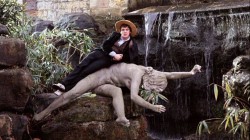
Owing to the nature of the story, it provided a perfect platform for Russell to incorporate his own views on art in several instances. We see it in the park just after Henri and Sophie have met when he decides to give a impromptu lecture on art (“Art is dirt! Art is sex! And art is—revolution!”). We see it in the amusing Louvre Museum scene where Henri has a run in with a stuffy guard (Peter Vaughan), who objects to the young man’s manner of dress and enthusiastically boisterous nature—objections that reach a peak when Henri climbs atop an Easter Island head (“Now that, sir, is stone—and very valuable stone—and if we allow one person to touch, then everyone will be wanting to touch it”). From that perch, Henri showers the crowd with his own drawings and offers another lecture—“Art is alive! Love it or hate it, but don’t worship it! You’re not in church!”

But Russell saves his strongest statement on art in what has been called the “torso scene”—where Henri spends the entire night chiseling away at a block of marble (stolen from a cemetery) to produce a nude female torso “in the neo-classical style” that he’s lied to the art dealer Shaw (John Justin) about already having done, and which Shaw has agreed to come see in the morning. As Henri works on the statue, he tells funny stories, obliquely cites W.B. Yeats, and expounds on the nature of art—and the relation of the artist to the world at large. “I need an audience!” he announces at one point, continuing, “There’s no such thing as an artist who doesn’t need an audience.” This goes on at length—and is quite beautifully done—to the point where he sums up the need for the work to be seen, “If there’s no one there to see it—‘Zut!’ as my divine sister would say. Just a lump of stone. Put St. Paul’s Cathedral in a cardboard box, and what have you got? A heavy box.” (Years later—in the wake of PBS cutting two key scenes out of his 1974 film Mahler—Russell sadly remarked to me, “Maybe St. Paul’s is better off in a cardboard box. At least there it’s safe from vandals.”)
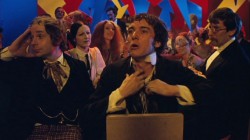
There is yet another level to the film—one that seems often overlooked—and that’s its relationship to the time in which it was made. It may be more or less coincidental that Scott Antony as Henri could pass for a rock star of the era, but his reassessment of Michelangelo with Beatle lyrics (“I have to admit he’s getting better—getting better all the time”) is certainly no accident. Nor was having Derek Jarman design Shaw’s nightclub in bright pop-art colors. There’s even one character presented in that scene with face painting that would be at home at Woodstock. And, of course, the connection between—and contrasts of—WWI and the Vietnam war are inescapable. The idea was clearly to make a movie that reflected—not always approvingly—the current (1972) era as well as the period in which the story takes place. It was meant to be relevant to a modern youthful audience. And it might well have succeeded had it been better promoted. It certainly succeeds artistically.
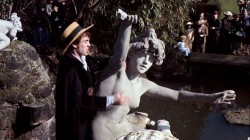
It’s remarkable to realize just how little money was at Russell’s disposal on the film, because nothing about it looks or feels cheap in the least. But to get some grasp on the situation, consider the use of classical music in the film. Russell uses Debussy’s “Three Nocturnes” and a stretch of Alexander Scriabin’s “The Divine Poem.” It would be impossible to imagine the movie without them (try thinking of the final scene without Debussy’s “Nuages”), but the budget didn’t actually allow for the rights to any recordings of them. The solution? Well, since the Soviet Union didn’t recognize foreign copyrights, neither did anyone outside the USSR recognize theirs—so the music came from Soviet LPs that were carefully edited to remove any pops or clicks. Someone back in the pre-DVD days asked me if I thought the film might have surround sound if it ever made it to laserdisc (it never did). I could only answer, “It’s lucky to have a soundtrack.”

In the end, of course, what matters isn’t intent or how it was done, but the final film. On that score, Savage Messiah succeeds beautifully. It is, if anything, better today than it ever was. Now, we needn’t so concern ourselves over the lack of fame of its stars, and can simply assess the strength of the performances. Scott Antony may have never achieved stardom and Dorothy Tutin may have remained mostly known for her stage work, but here—for 99 minutes—they will always be stars. Helen Mirren would go on to bigger—not always better—roles and considerably greater fame, but whether she ever outdistanced the bravery (and I’m not talking about taking her clothes off) of this performance is open to question. In fact, everyone is splendid in the movie, which is always so obviously a labor of love—and that love shines through in every scene.
And as for that “simple” reading of the film as “The story of a young French art student and the lonely Polish woman he met in Paris just before the First World War,” the film never forgets to be that. And a wondrous, touching, ultimately heartbreaking story it is. Honestly, I have never made it through the film dry-eyed. I doubt I ever will. And I’m not sure I want to meet the person who can.



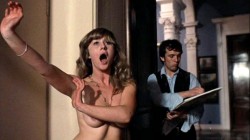
You really love that quote, don’t you.
Hey, it’s a terrific quote. (I just wish I could find my poster that has it on it.) It’s also unintentionally ironic because while it’s true, it’s also about most un-erotic thing imaginable.
It’s also unintentionally ironic because while it’s true, it’s also about most un-erotic thing imaginable.
I’m not sure I agree with that.
I’m pretty sure it’s not meant to be erotic in any case.
By the way, the lack of photos on here is due to Miami Steve being sick. He promises to put them in in the morning. (And, yes, that also means we aren’t doing the podcast recording till Thursday. That gives you a little extra time on the artwork.)
By the way, the lack of photos on here is due to Miami Steve being sick. He promises to put them in in the morning.
I’m happy to pick out an un-erotic still for him to use for this film.
” it’s also about most un-erotic thing imaginable.”
Hmmmm, I don’t know. For me, ‘Showgirls’ wins that award. But then again, I’ve not seen this film.
Bear in mind, I’m not calling the film un-erotic, merely that nude scene.
I’m happy to pick out an un-erotic still for him to use for this film.
As you can see, this has been modestly addressed. You may also note that the review got bigger.
You may also note that the review got bigger.
I was curious about that. I thought you weren’t well if that’s all you had to say about a Ken Russell film.
I was curious about that. I thought you weren’t well if that’s all you had to say about a Ken Russell film.
I actually wasn’t up to par (even par for me) Monday or Tuesday, but since this is my “day off” I managed to improve things.
I see a nipple. A first for the Xpress?
I see a nipple.
No such thing. You see the edge of a nipple.
A first for the Xpress?
http://www.mountainx.com/movies/review/prospero_books
One of the greatest love stories ever filmed but a purely unconventional one (what else would we expect from Mr. Russell?). It’s true that the film gets better and better with repeat viewings and the remastered dvd is a revelation.
I, also, have yet to get through it without tearing up as well. A close friend recently saw it for the first time and declared, “It may the best movie ever made.” He won’t get much of an argument from me!
I feel very cautious about calling a movie my absolute favorite, simply because I feel a bit young to make that statement and it tends to change. But let’s just say for now “Savage Messiah” is.
(Previously it was “Boogie Nights,” and while I love that film, I’ve seen so much more due to the Asheville Film Society screenings, that I feel a bit older since.)
“Savage Messiah” is so charismatic and endearing, it maybe the most passionate movie I’ve seen. Not to be missed!
Not to be missed!
Then make sure you don’t.
I shall be endeavouring to pick up the remastered DVD of this when I’m in the states in a few weeks.
I shall be endeavouring to pick up the remastered DVD of this when I’m in the states in a few weeks.
Keep in mind that this title is manufactured on demand. It won’t be in stores. I stock a couple here and there, but I cannot return them to my distributor.
But if you PROMISE to pick one up I’ll order it in advance for you.
Then make sure you don’t.
I maybe feeling near death, but I will muster all will to be there.
Are you planning on feeling near death?
Are you planning on feeling near death?
I am preparing for it.
What a gloomy outlook. I now envision you having to rise from your Bed of Pain to veritably crawl to The Carolina.
How did this go over?
It hasn’t yet. It’s on Tuesday.
First of all, Mr. Tonberry did indeed manage to haul himself to the screening. Second, so did about 80 other people, which means we were out of seats, chairs, folding chairs, barstools, and floor (I watched the film standing up). Three of them had seen the film before. And about 2/3’s of them were new to Ken Russell altogether (how this can be is remarkable to me).
The overall response was enthusiastic — in some cases enthusiastic and then some. There was one couple who I think were disappointed — or possibly worse — and I felt bad about that because he’d very nicely brought in his first edition copy of the book. And that in itself was, I suspect, the problem — they had very firm ideas on the real people as they perceived them from the book. Those ideas did not match the film. I guess it’s hard for me to look at it that way, but I’m coming at it as a Ken Russell film first and foremost. Plus, I saw the film before I read the book. And I read the book once around 1982. The film I’ve seen at least 25 times.